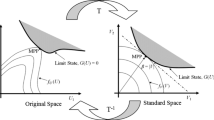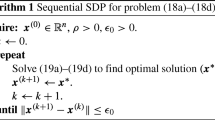Abstract
In view of the significant influences of multi-source uncertainties on structural safety, which generally exist in practical engineering (such as the dispersion of material, the uncertainty of external load and the error of processing technology), more academic research and engineering applications had paid attention to uncertainty in recent years. However, due to the complexity of the structural problems, there may be multiple uncertain parameters. Traditional methods of optimal design by single-source uncertainty model, particularly the one derived from probability theory, may no longer be feasible. This paper investigates a new formulation and numerical solution of reliability-based design optimization (RBDO) of structures exhibiting random and uncertain-but-bounded (interval and convex) mixed uncertainties. Combined with the non-probabilistic set-theory convex model and the classical probabilistic approach, the mathematical definition of hybrid reliability is firstly presented for a quantified measure of the safety margin. The reliability-based optimization incorporating such mixed reliability constraints is then formulated. The PSO algorithm is employed to improve the convergence and the stability in seeking the optimal global solution. Additionally, by introducing the general concept of the safety factor, the compatibility between the proposed hybrid RBDO technique and the safety factor-based model is further discussed. By virtue of the above two methods, two numerical examples of typical components (the cantilever structure and the truss structure) as well as one complex engineering example (the hypersonic wing structure) are performed, subjected to the strength or stiffness criteria. The accuracy and effectiveness of the present method are then demonstrated.


















Similar content being viewed by others
References
Elishakoff, I.: Probabilistic Theory of Structures. Courier Dover Publications, Mineola (1999)
Ditlevsen, O., Madsen, H.O.: Structural Reliability Methods. Citeseer, Princeton (1996)
Madsen, H.O., Krenk, S., Lind, N.C.: Methods of structural safety. DoverPublications.com (2006)
Lemaire, M.: Structural Reliability. Wiley, London (2009)
Kleiber, M., Tran, D.H.: The Stochastic Finite Element Method: Basic Perturbation Technique and Computer Implementation. Wiley, New York (1992)
Qin, Q., Lin, D.J., Mei, G.: Theory and Applications: Reliability Stochastic Finite Element Methods. Tsinghua University Press, Bei**g (2006)
Hasofer, A.M., Lind, N.C.: An exact and invariant first order reliability format. J. Eng. Mech. 100, 111–120 (1974)
Hohenbichler, M., Rackwitz, R.: Improvement of second-order reliability estimates by importance sampling. J. Eng. Mech. 114, 2195–2199 (1988)
Breitung, K.: Asymptotic approximations for probability integrals. Probab. Eng. Mech. 4, 187–190 (1989)
Polidori, D.C., Beck, J.L., Papadimitriou, C.: New approximations for reliability integrals. J. Eng. Mech. 125, 466–475 (1999)
Balu, A.S., Rao, B.N.: Inverse structural reliability analysis under mixed uncertainties using high dimensional model representation and fast Fourier transform. Eng. Struct. 37, 224–234 (2012)
Elishakoff, I.: Discussion on the paper: a non-probabilistic concept of reliability. Struct. Saf. 17, 195–199 (1995)
Ben-Haim, Y.: Robust reliability of structures. Adv. Appl. Mech. 33, 1–41 (1997)
Qiu, Z.P., Mueller, P.C., Frommer, A.: The new nonprobabilistic criterion of failure for dynamical systems based on convex models. Math. Comput. Model. 40, 201–215 (2004)
Jiang, T., Chen, J.J., Xu, Y.L.: A semi-analytic method for calculating non-probabilistic reliability index based on interval models. Appl. Math. Model. 31, 1362–1370 (2007)
Chen, X.Y., Tang, C.Y., Tsui, C.P., Fan, J.P.: Modified scheme based on semi-analytic approach for computing non-probabilistic reliability index. Acta Mech. Solid. Sin. 23, 115–123 (2010)
Jiang, C., Han, X., Lu, G.Y., Liu, J., Zhang, Z., Bai, Y.C.: Correlation analysis of non-probabilistic convex model and corresponding structural reliability technique. Comput. Methods Appl. Mech. Eng. 200, 2528–2546 (2011)
Jiang, C., Bi, R.G., Lu, G.Y., Han, X.: Structural reliability analysis using non-probabilistic convex model. Comput. Methods Appl. Mech. Eng. 254, 83–98 (2013)
Moens, D., Vandepitte, D.: Recent advances in non-probabilistic approaches for non-deterministic dynamic finite element analysis. Arch. Comput. Methods Eng. 13, 389–464 (2006)
Möller, B., Beer, M.: Engineering computation under uncertainty—capabilities of non-traditional models. Comput. Struct. 86, 1024–1041 (2008)
Elishakoff, I., Ohsaki, M.: Optimization and Anti-Optimization of Structures Under Uncertainty. Imperial College Press, London (2010)
Guo, S.X., Lu, Z.Z.: Hybrid probabilistic and non-probabilistic model of structural reliability. J. Eng. Mech. 24, 524–526 (2002)
Du, X.P., Sudjianto, A., Huang, B.Q.: Reliability-based design with the mixture of random and interval variables. J. Mech. Design 2005, 127 (1068)
Luo, Y.J., Kang, Z., Li, A.: Structural reliability assessment based on probability and convex set mixed model. Comput. Struct. 87, 1408–1415 (2009)
Jiang, C., Li, W.X., Han, X., Liu, L.X., Le, P.H.: Structural reliability analysis based on random distributions with interval parameters. Comput. Struct. 89, 2292–2302 (2011)
Jiang, C., Lu, G.Y., Han, X., Liu, L.X.: A new reliability analysis method for uncertain structures with random and interval variables. Int. J. Mech. Mater. Design 8, 169–182 (2012)
Elishakoff, I., Colombi, P.: Combination of probabilistic and convex models of uncertainty when scarce knowledge is present on acoustic excitation parameters. Comput. Methods Appl. Mech. Eng. 104, 187–209 (1993)
Penmetsa, R.C., Grandhi, R.V.: Efficient estimation of structural reliability for problems with uncertain intervals. Comput. Struct. 80, 1103–1112 (2002)
Hall, J.W., Lawry, J.: Generation, combination and extension of random set approximations to coherent lower and upper probabilities. Reliab. Eng. Syst. Saf. 85, 89–101 (2004)
Qiu, Z.P., Wang, J.: The interval estimation of reliability for probabilistic and non-probabilistic hybrid structural system. Eng. Fail. Anal. 17, 1142–1154 (2010)
Beck, A.T., Gomes, W.J.S.: A comparison of deterministic, reliability-based and risk-based structural optimization under uncertainty. Probab. Eng. Mech. 28, 18–29 (2012)
Nikolaidis, E., Burdisso, R.: Reliability based optimization: a safety index approach. Comput. Struct. 28, 781–788 (1988)
Tu, J., Choi, K.K., Park, Y.H.: A new study on reliability-based design optimization. J. Mech. Design 121, 557–564 (1999)
Aoues, Y., Chateauneuf, A.: Benchmark study of numerical methods for reliability-based design optimization. Struct. Multidiscip. Optim. 41, 277–294 (2010)
Byeong, H.J., Byung, C.L.: Reliability-based design optimization using a moment method and a kriging metamodel. Eng. Optim. 40, 421–438 (2008)
Chen, Z.Z., Qiu, H.B., Gao, L., Su, L., Li, P.G.: An adaptive decoupling approach for reliability-based design optimization. Comput. Struct. 117, 58–66 (2013)
Elishakoff, I., Haftka, R.T., Fang, J.: Structural design under bounded uncertainty optimization with anti-optimization. Comput. Struct. 53, 1401–1405 (1994)
Qiu, Z.P., Elishakoff, I.: Antioptimization of structures with large uncertain-but-non-random parameters via interval analysis. Comput. Methods Appl. Mech. Eng. 152, 361–372 (1998)
Lombardi, M., Haftka, R.T.: Anti-optimization technique for structural design under load uncertainties. Comput. Methods Appl. Mech. Eng. 157, 19–31 (1998)
Pantelides, C.P., Ganzerli, S.: Design of trusses under uncertain loads using convex models. J. Struct. Eng. 124, 318–329 (1998)
Jiang, C., Han, X., Liu, G.R.: Optimization of structures with uncertain constraints based on convex model and satisfaction degree of interval. Comput. Methods Appl. Mech. Eng. 196, 4791–4800 (2007)
Luo, Y., Kang, Z., Luo, Z., Li, A.: Continuum topology optimization with non-probabilistic reliability constraints based on multi-ellipsoid convex model. Struct. Multidiscip. Optim. 39, 297–310 (2009)
Kang, Z., Luo, Y.J., Li, A.: On non-probabilistic reliability-based design optimization of structures with uncertain-but-bounded parameters. Struct. Saf. 33, 196–205 (2011)
Ge, R., Chen, J.Q., Wei, J.H.: Reliability-based design of composites under the mixed uncertainties and the optimization algorithm. Acta Mech. Solid. Sin. 21, 19–27 (2008)
Luo, Y., Li, A., Kang, Z.: Reliability-based design optimization of adhesive bonded steel-concrete composite beams with probabilistic and non-probabilistic uncertainties. Eng. Struct. 33, 2110–2119 (2011)
Yao, W., Chen, X.Q., Huang, Y.Y., Gurdal, Z., Michel, V.T.: Sequential optimization and mixed uncertainties analysis method for reliability-based optimization. AIAA J. 51, 2266–2277 (2013)
Wang, X., Qiu, Z., Elishakoff, I.: Non-probabilistic set-theoretic model for structural safety measure. Acta Mech. 198, 51–64 (2008)
Wang, X., Wang, L., Elishakoff, I., Qiu, Z.: Probability and convexity concepts are not antagonistic. Acta Mech. 219, 45–64 (2011)
Acknowledgments
The authors would like to thank the National Nature Science Foundation of China (Nos. 11372025, 11572024, 11432002) and the Defense Industrial Technology Development Program (Nos. JCKY2013601B, JCKY2016601B) for the financial supports. Besides, the authors wish to express their many thanks to the reviewers for their useful and constructive comments.
Author information
Authors and Affiliations
Corresponding author
Appendix
Appendix
Case (a): As is shown in Fig. 5a, when \(Y_1 \) is assigned to the maximum \(\overline{Y_1 } \) or minimum \(\underline{Y_1 }\), there is no intersection between the limit-state and the feasible domain, and the distance from the origin to the failure surface would be greater than unity. Hence, we have
Then, the span of \(f({\varvec{x}})\) is
Obviously, once the given \({\varvec{x}}\) satisfies (38), it is definitely safe with a reliability index \(\eta \left( {{\varvec{d}},{\varvec{x}}} \right) =1\).
Case (b): As is shown in Fig. 5b, when \(Y_1 =\underline{Y_1 }\), there is no intersection between the limit-state and the feasible domain of uncertain variables; when \(Y_1 =\overline{Y_1 } \), the interference occurs, and the distance \(D_1 ({\varvec{x}},\overline{Y_1 } )\) would be within an interval \([0,\;1]\), namely
It is apparent that
In this case, the reliability index \(\eta \left( {{\varvec{d}},{\varvec{x}}} \right) \) is defined as the volume ratio between the transparent region and the total region. So, it reads
where \(V_\mathrm{total} =(\overline{Y_1 } -\underline{Y_1 })\pi \). By virtue of the integral operation, \(V_\mathrm{failure} \) can be expressed as
where \(S_1 ({\varvec{x}},Y_1 )\) stands for the area of the bow-shaped interference region which implies failure (its analytical expression has been deduced by our previous work in Ref. [48]); \(Y_1^\alpha \) denotes the value of \(Y_1 \) when it satisfies \(D_1 ({\varvec{x}},Y_1 )=1\), i.e.,
Therefore, \(\eta \left( {{\varvec{d}},{\varvec{x}}} \right) \) can be expanded as
Case (c): As is shown in Fig. 5c, differ from case (b), the distance from the origin to the failure surface is \(D_2 ({\varvec{x}},\overline{Y_1 } )\in \left[ {0,\;1} \right] \) when \(Y_1 =\overline{Y_1 } \). Hence, \(V_\mathrm{failure} \) can be represented as
where \(Y_1^\beta \) denotes the value of \(Y_1 \) when it satisfies \(D_2 ({\varvec{x}},Y_1 )=0\), i.e.,
Substituting (45), (46) into (41), we obtain
Case (d): As is shown in Fig. 5d, similar to the cases discussed before, but the distance \(D_2 ({\varvec{x}},\overline{Y_1})\) greater than unity, the expression of \(V_\mathrm{failure}\) is changed as
where \(Y_1^\gamma \) denotes the value of \(Y_1 \) when it satisfies \(D_2 ({\varvec{x}},Y_1 )=1\), i.e.,
Substituting (48), (49) into (41), we obtain
Rights and permissions
About this article
Cite this article
Wang, L., Wang, X., Wang, R. et al. Reliability-based design optimization under mixture of random, interval and convex uncertainties. Arch Appl Mech 86, 1341–1367 (2016). https://doi.org/10.1007/s00419-016-1121-0
Received:
Accepted:
Published:
Issue Date:
DOI: https://doi.org/10.1007/s00419-016-1121-0




